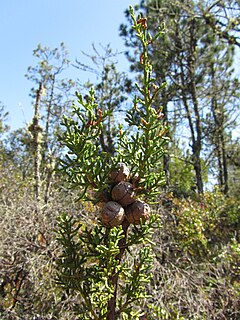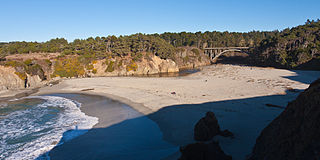
Arctostaphylos is a genus of plants comprising the manzanitas and bearberries. They are shrubs or small trees.

The Northern California coastal forests are a temperate coniferous forests ecoregion of coastal Northern California.

Cupressus pigmaea, the Mendocino cypress or pygmy cypress, is a taxon of disputed status in the genus Cupressus endemic to certain coastal terraces and coastal mountain ranges of Mendocino and Sonoma Counties in northwestern California. It is a highly variable tree, and closely related to Cupressus goveniana, enough to sometimes be considered a subspecies of it.

Mount Hood, also known as Hood Mountain is a mountain near the southeastern edge of Santa Rosa, California at the northeast of the Sonoma Valley and attains a height of 2,733 feet (833 m). The original name was Mount Wilikos, an Indian name meaning "willows." Most of the drainage from Mount Hood contributes to the headwaters of Sonoma Creek. A prominent feature is the extensive rock face visible on the upper half of the mountain as viewed from State Route 12. The habitats on the mountain include mixed oak forest, pygmy forest, chaparral and riparian zones. In prehistoric times the slopes of Mount Hood were inhabited by a division of the Yuki tribe. Most of Mount Hood is within the Hood Mountain Regional Park maintained by Sonoma County. Mount Hood is part of the inner coast Mayacamas Range, and lies mostly within Sonoma County, with a part of the mountain geographically within Napa County. Mount Hood affords overlooks of the Pacific Ocean, San Francisco Bay and "a spectacular view east to the Sierra Nevada Range."

Dwarf forest, elfin forest, or pygmy forest is an uncommon ecosystem featuring miniature trees, inhabited by small species of fauna such as rodents and lizards. They are usually located at high elevations, under conditions of sufficient air humidity but poor soil. There are two main dwarf forest ecosystem types, involving different species and environmental characteristics: coastal temperate and montane tropical regions. Temperate coastal dwarf forest is common for parts of Southern California. Montane tropical forests are found across tropical highlands of Central America, northern South America and Southeast Asia. There are also other isolated examples of dwarf forests scattered across the world, while the largest dwarf forest is found in the Philippines.

Arctostaphylos morroensis is a species of manzanita known by the common name Morro manzanita. This shrub is endemic to San Luis Obispo County, California, where it is known only from the vicinity of Morro Bay.

Arctostaphylos tomentosa is a species of manzanita known by the common name woollyleaf manzanita or woolley manzanita. This shrub is endemic to California.

Arctostaphylos pallida, commonly known as Pallid Manzanita, Oakland Hills Manzanita, and Alameda Manzanita, is an upright Manzanita shrub from the Ericaceae, or heath family. It is endemic to the eastern San Francisco Bay Area of Northern California.

Arctostaphylos densiflora, known by the common name Vine Hill manzanita, is a very rare species of manzanita. It is endemic to Sonoma County, California, where it is known from only one extant population of 20 to 30 individual plants. These last wild members of the species are on land near Sebastopol which is owned and protected by the California Native Plant Society. In addition, there are five to ten plants of this manzanita taxon growing on private property about a mile away. The local habitat is mostly chaparral on sandy shale soils.

Arctostaphylos imbricata is a species of manzanita known by the common name San Bruno Mountain manzanita.

Arctostaphylos myrtifolia is a rare species of manzanita known by the common name Ione manzanita. It is endemic to the Sierra Nevada foothills of California. It grows in the chaparral and woodland plant community on a distinctive acidic soil series in western Amador and Calaveras Counties. There are only about 17 occurrences, but the plant is abundant in some areas of its limited range. This is a federally listed threatened species.

Arctostaphylos osoensis is a species of manzanita known by the common name Oso manzanita. It is endemic to San Luis Obispo County, California, where it is known from only two occurrences on the northern edge of the Los Osos Valley.
Arctostaphylos pechoensis is a species of manzanita known by the common name Pecho manzanita. It is endemic to California, where it is known only from the Pecho Hills southwest of San Luis Obispo in San Luis Obispo County, California.

Arctostaphylos refugioensis is a species of manzanita, known by the common name Refugio manzanita. It is endemic to Santa Barbara County, California, where it can be found along the immediate coastline, including the vicinity of Refugio State Beach, and into the Santa Ynez Mountains of the northwestern Transverse Ranges.

Arctostaphylos rudis, with the common names Shagbark manzanita and Sand mesa manzanita, is a species of manzanita.

Arctostaphylos virgata is a species of manzanita known by the common names Bolinas manzanita and Marin manzanita.

The Elfin Forest Natural Area is a nature preserve protecting a unique plant community in Los Osos-Baywood Park, San Luis Obispo County, central California. It consists of prehistoric sand dunes, rising 150 feet (46 m) above southern Morro Bay, on the north of Los Osos-Baywood Park.

Arctostaphylos gabilanensis is a rare species of manzanita known by the common name Gabilan manzanita.

Jug Handle State Natural Reserve is a state park unit of California, United States, preserving a series of marine terraces each exhibiting a different stage of ecological succession. It is located on California State Route 1 north of the village of Caspar, five miles (8 km) equidistant between the towns of Mendocino and Fort Bragg. The 776-acre (314 ha) park was established in 1976.
Arctostaphylos nortensis, common name Del Norte manzanita, is a shrub narrowly endemic to the mountains along the Oregon/California state line. It has been reported from only 3 counties: Del Norte County, California; and Curry and Josephine Counties in Oregon. The plant grows in chaparral and open forests at elevations of 400–600 m (1,300–2,000 ft).


















